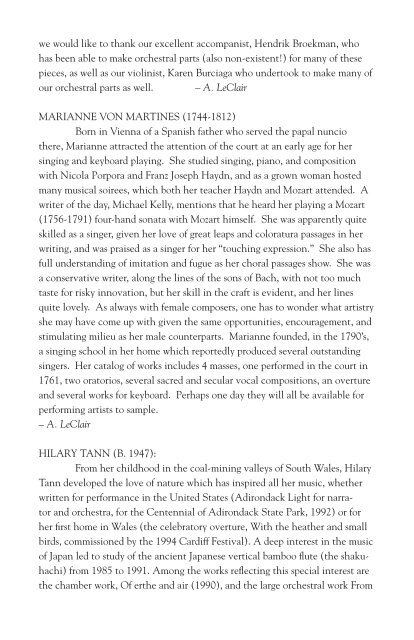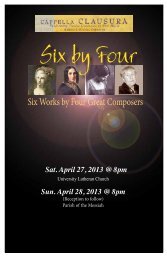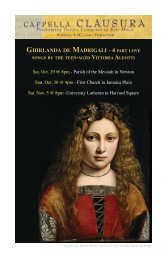The Female Mozart? - Cappella Clausura
The Female Mozart? - Cappella Clausura
The Female Mozart? - Cappella Clausura
You also want an ePaper? Increase the reach of your titles
YUMPU automatically turns print PDFs into web optimized ePapers that Google loves.
we would like to thank our excellent accompanist, Hendrik Broekman, who<br />
has been able to make orchestral parts (also non-existent!) for many of these<br />
pieces, as well as our violinist, Karen Burciaga who undertook to make many of<br />
our orchestral parts as well. – A. LeClair<br />
MARIANNE VON MARTINES (1744-1812)<br />
Born in Vienna of a Spanish father who served the papal nuncio<br />
there, Marianne attracted the attention of the court at an early age for her<br />
singing and keyboard playing. She studied singing, piano, and composition<br />
with Nicola Porpora and Franz Joseph Haydn, and as a grown woman hosted<br />
many musical soirees, which both her teacher Haydn and <strong>Mozart</strong> attended. A<br />
writer of the day, Michael Kelly, mentions that he heard her playing a <strong>Mozart</strong><br />
(1756-1791) four-hand sonata with <strong>Mozart</strong> himself. She was apparently quite<br />
skilled as a singer, given her love of great leaps and coloratura passages in her<br />
writing, and was praised as a singer for her “touching expression.” She also has<br />
full understanding of imitation and fugue as her choral passages show. She was<br />
a conservative writer, along the lines of the sons of Bach, with not too much<br />
taste for risky innovation, but her skill in the craft is evident, and her lines<br />
quite lovely. As always with female composers, one has to wonder what artistry<br />
she may have come up with given the same opportunities, encouragement, and<br />
stimulating milieu as her male counterparts. Marianne founded, in the 1790’s,<br />
a singing school in her home which reportedly produced several outstanding<br />
singers. Her catalog of works includes 4 masses, one performed in the court in<br />
1761, two oratorios, several sacred and secular vocal compositions, an overture<br />
and several works for keyboard. Perhaps one day they will all be available for<br />
performing artists to sample.<br />
– A. LeClair<br />
HILARY TANN (B. 1947):<br />
From her childhood in the coal-mining valleys of South Wales, Hilary<br />
Tann developed the love of nature which has inspired all her music, whether<br />
written for performance in the United States (Adirondack Light for narrator<br />
and orchestra, for the Centennial of Adirondack State Park, 1992) or for<br />
her first home in Wales (the celebratory overture, With the heather and small<br />
birds, commissioned by the 1994 Cardiff Festival). A deep interest in the music<br />
of Japan led to study of the ancient Japanese vertical bamboo flute (the shakuhachi)<br />
from 1985 to 1991. Among the works reflecting this special interest are<br />
the chamber work, Of erthe and air (1990), and the large orchestral work From





